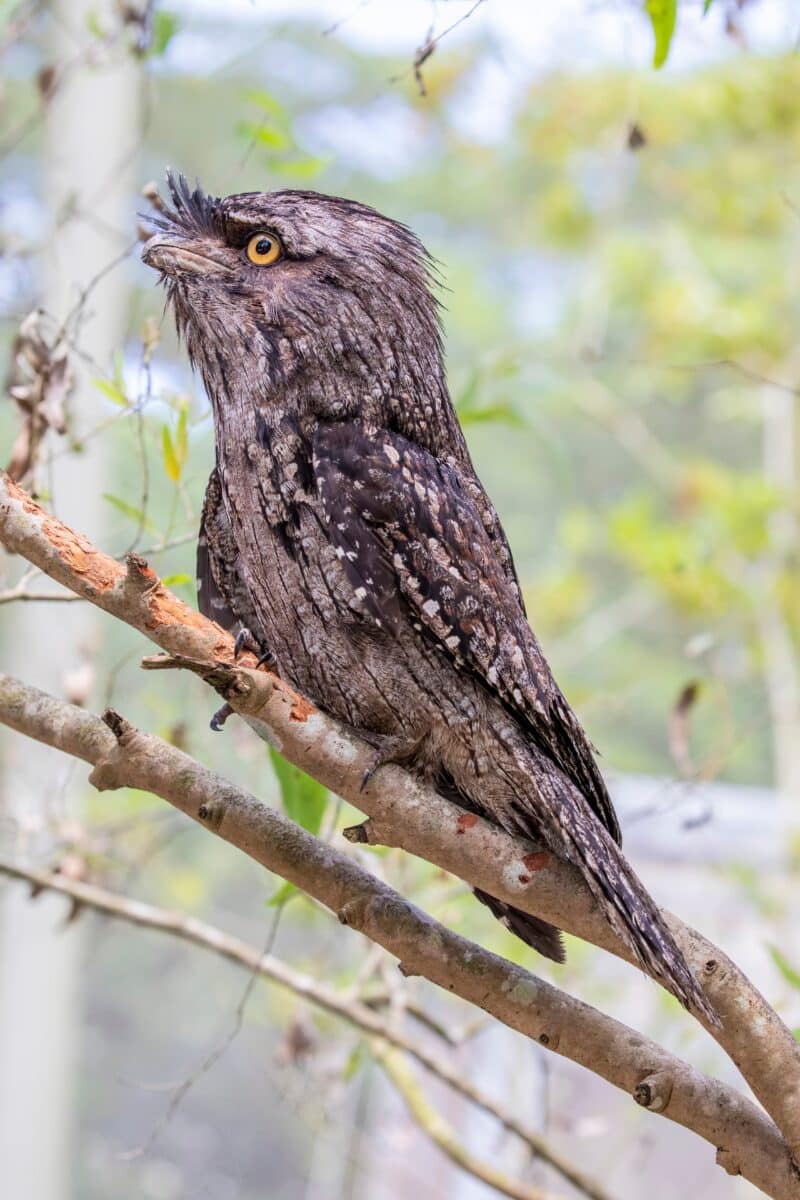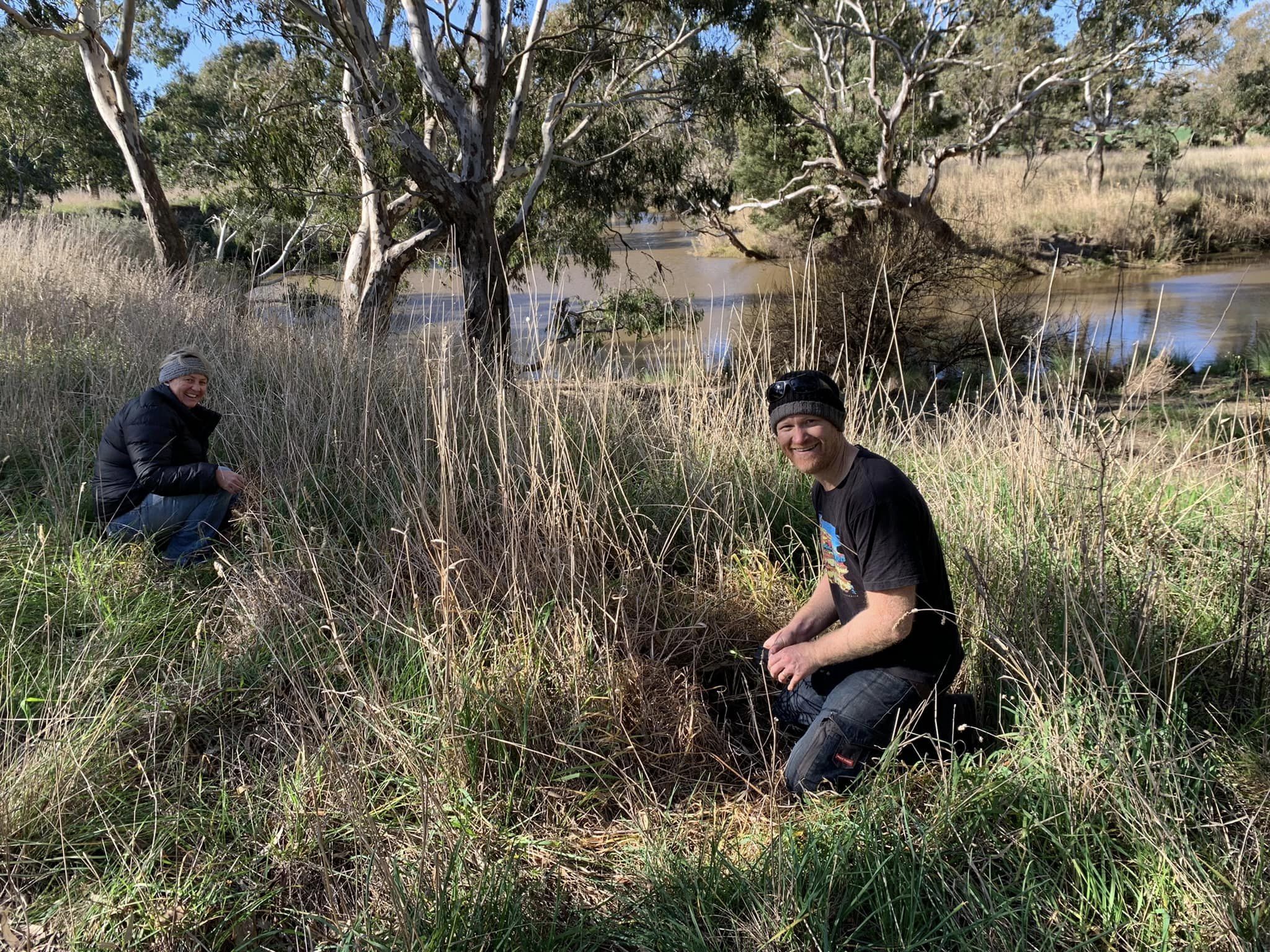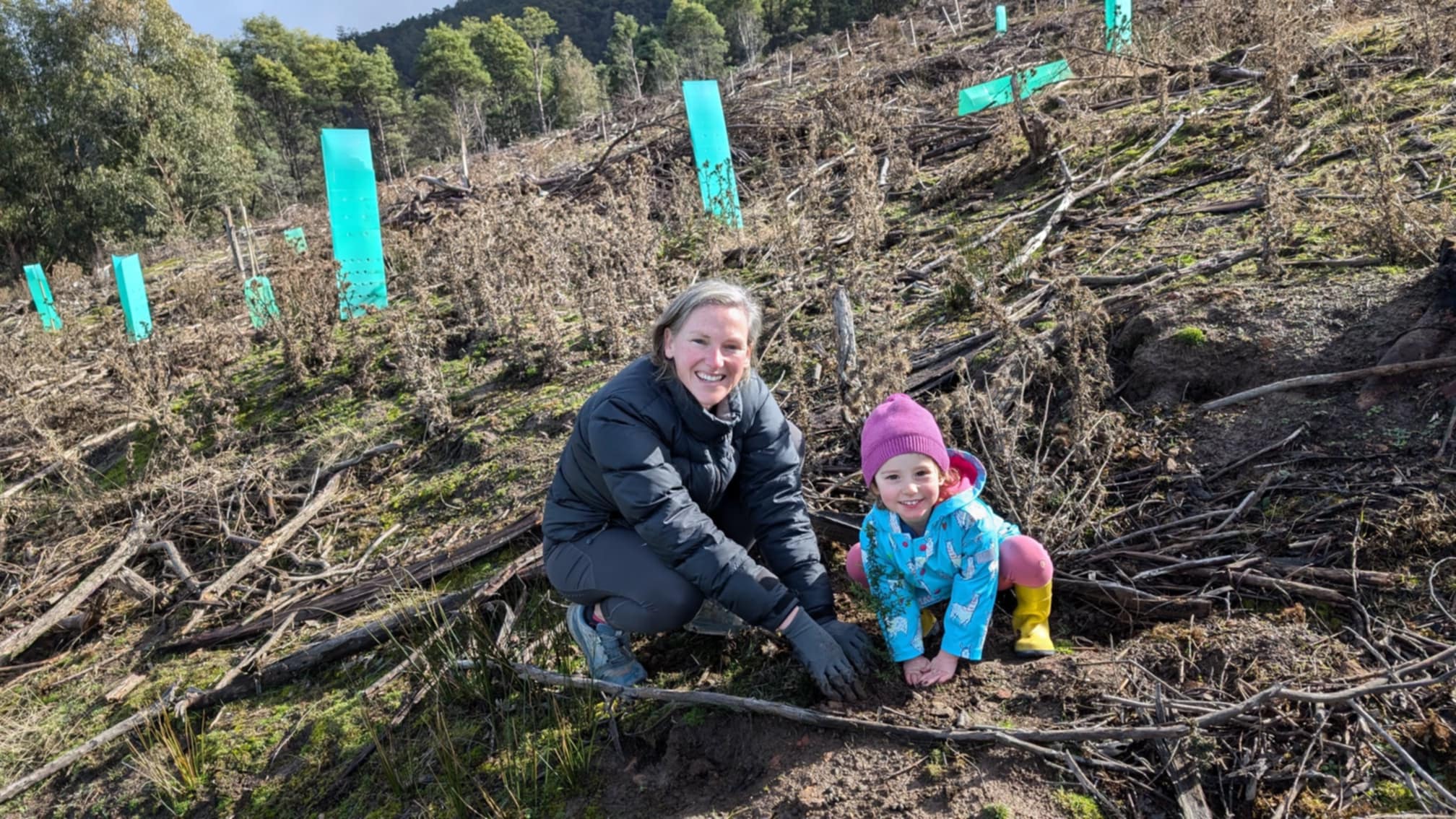We have a slight obsession here with a bird that doesn’t get a lot of attention, but is nevertheless an iconic Australian bird that oozes personality. This year, we are focusing on planting habitat trees for these beautiful creatures. So, we wanted to tell you a little more about them, so you will not only come to appreciate them but also to gain some knowledge and understanding.
Would you like to support? Here’s the link where you can purchase trees for the Tawnys.
WHAT’S IN A NAME?
The scientific name for the Tawny Frogmouth is Podargus strigoides. The name is latin, podagra = gout. This refers to the small, presumably weak feet of the frogmouth. Some say they walk ‘like a gouty old man’ and strigoides is from the Latin strix meaning ‘owl,’ and –oides, meaning ‘in the shape of’.
Thus the scientific name means: ‘gouty owl-like’. Frogmouths do resemble owls, but they belong to a different order (Caprimulgiformes) and are more closely related to nightjars. The name frogmouth refers to the shape of the beak, they have a very wide mouth with a huge gape, like a frog!
Frogmouths play a vital role in natural ecosystems. Studies of banded birds show that tawny frogmouths can live for up to 14 years in the wild.
WHAT DO THEY LOOK LIKE?
These are chunky birds, with big heads and long rounded tails. Tawny frogmouths have greyish feathers, lighter below, streaked with darker grey and some reddish tints. Their large eyes have a yellow iris, and the inside of the wide, heavy beak is yellow. Both males and females can reach 53cm in length, and weigh up to 680 grams. For their size, they tend to be heavier than owls.
Frogmouths are masters of camouflage: during the day they sit motionless, with eyes closed, feathers compacted, and beak upraised near the trunk of a tree or on a post, looking uncannily like a dead branch.

WHAT’S THE DIFFERENCE BETWEEN FROGMOUTHS AND OWLS?
Owls and frogmouths are nocturnal predators, but not closely related. Owls are raptors and have large strong feet armed with long curved talons. They hunt while flying, listening for the faint rustlings of mice and lizards, and swoop down on silent wings to grasp their prey in their claws. They then use their beak to tear the prey into bite size pieces. Frogmouths are more closely related to nightjars. Their feet are small. They tend to perch motionless on a branch, waiting for prey to come within reach. Prey is caught in their wide mouth and crushed with the side of the beak. They take much smaller prey species than owls.
The eyes of an owl face forward, while the eyes of a frogmouth are located on the side of its head.
WHERE DO THEY LIVE
These birds are found throughout mainland Australia and Tasmania, in most habitats except for dense rainforest and deserts. They require mature trees, both for nesting and roosting. Trees with dead branches are preferred because they offer the best background for their cryptic daytime posture. Tawny frogmouths have adapted to human settlement: they are often seen in suburban gardens and parks, and feed on insects attracted to streetlights.
SPECIAL ADAPTATIONS
Tawny frogmouths have very large eyes and an excellent sense of hearing, which helps them locate prey in the dark. At the base the beak are tufts of stiff feathers called rictal bristles. These may help to detect the movement of prey such as flying insects (though this has not been proven). It has been observed these bristles help protect the frogmouth’s face and eyes from its prey.
The pattern of streaking on their feathers provides excellent camouflage as they are roosting. If they remain perfectly still, they look exactly like a dead branch. If the frogmouth does feel threatened, it opens its beak, revealing the bright yellow lining, and threatens with loud clacking sounds.
Would you like to support? Here’s the link where you can purchase trees for the Tawnys.
NESTING AND RAISING THE YOUNG
Tawny frogmouths form permanent pair bonds for the life of the individual bird. The pair will remain in the same territory for 10 years or more. Nesting season is generally August through November. In the southern parts of the country, they may nest twice during the springtime. Male and female call back and forth to each other as mating season begins.
The nest is built rather flimsily of broken twigs, set on a branch or in the fork of a tree, up to 20 metres above the ground. Often the same nest site is used year after year. Two to three dullish white eggs are laid. Male and female take turns incubating the eggs; the male generally sits during the day, and the female at night. Chicks hatch after a month. Both parents help to feed them until they are fledged, in about a month’s time. During this time the whole family may be seen roosting side by side on a branch.
THREATS TO THE ON GOING HEALTH OF THE POPULATION
Frogmouths are widespread across all states of Australia and they are not considered a species threatened with extinction. While their conservation status is Least Concern, there are threats to their population numbers due to:
- Large-scale land-clearing of mature eucalyptus trees and intense bushfires. Frogmouths don’t readily move to other areas if their homes are destroyed.
- Introduced predators such as foxes and cats. When frogmouths pounce to catch prey on the ground, they are slow to return to flight. This leaves them vulnerable to attack. Cats may also prey on young birds.
- Widespread use of insecticides and rodent poisons. The toxins that remain in the target animals can be fatal to a frogmouth that eats them.
In 2024, we are looking to support community projects that are planting trees for revegetation projects in Tawny Frogmouth county. To date, we have sites at Bendigo (Dja Dja Wurrung) and Grampians (Gariwerd) in Victoria, Brighton (Mumirimina land) in Tasmania, and Esperance (Kepa Kurl). Stay tuned for more updates as we collect sites in South Australia, New South Wales and Queensland.
Would you like to support? Here’s the link where you can purchase trees for the Tawnys.
Some of the best places to find Tawnys in could be in your very own backyard. If you have no luck (they are difficult to spot), head to a nearby sanctuary, zoo or park. Here’s some visiting suggestions from across Australia.
Bonorong Wildlife Sanctuary (TAS). Bonorong is a means to help Tasmania’s fragile wildlife and ecology. The Sanctuary is focused on giving back to the Tasmanian environment, rather than simply being a showcase.
Serendip Sanctuary (VIC). See kangaroos, wallabies, emus and a huge variety of birdlife (including the Tawnys) in their natural habitat as you explore the walks at Serendip Sanctuary. There are four interconnecting trails throughout the sanctuary, all within walking distance from the Information Centre. Each trail is no longer than 2km return.
Healsville Sanctuary. (VIC). Zoos Victoria runs this sanctuary, along with Melbourne Zoo, Werribee Open Range Zoo and Kyabram Fauna Park. At Healsville, you can meet the resident Tawnys. See their amazing camouflage skills first-hand. You’ll also learn some birdwatching basics to help you spot some of the other unique bird species native to Australia.
Adelaide Zoo (SA). Adelaide Zoo, one of Adelaide’s most iconic attractions, is home to more than 2,500 animals and 250 species of exotic and native mammals, birds, reptiles and fish exhibited over eight hectares of magnificent botanic surroundings. It is the second oldest zoo in the nation.
Caversham Wildlife Park (WA). Spend the day at one of Perth’s most exciting tourist attractions, showcasing the largest private collection of native wildlife in Western Australia.
Billabong Sanctuary (QLD). Australia’s Best Interactive Wildlife Experiences! Rated as one of the best things to do in Townsville, get up close and personal with your favourite Australian animals.
Centennial Parklands (NSW). Centennial Parklands is one of the world’s leading public parklands. In Sydney this park is known as ‘the lungs of the city’.
Information sourced from Healesville Sanctuary and ‘Tawny Frogmouth’ by Prof. Gisela Kaplan (CSIRO 2018). To listen to Gisela talk about why our native birds are so unique and smart, check out her interview with Australian Geographic (38min).
Writer: Colleen B. Filippa
With a background in Environmental Science, Colleen is the Founding Director of Fifteen Trees. In 2009, after 20 years in primary, secondary and tertiary education institutions, Colleen left the classroom to start the company. Fifteen Trees is a social enterprise assisting individuals and companies to reduce their carbon footprint by supporting Australian community groups such as Landcare, schools and environmental networks.


